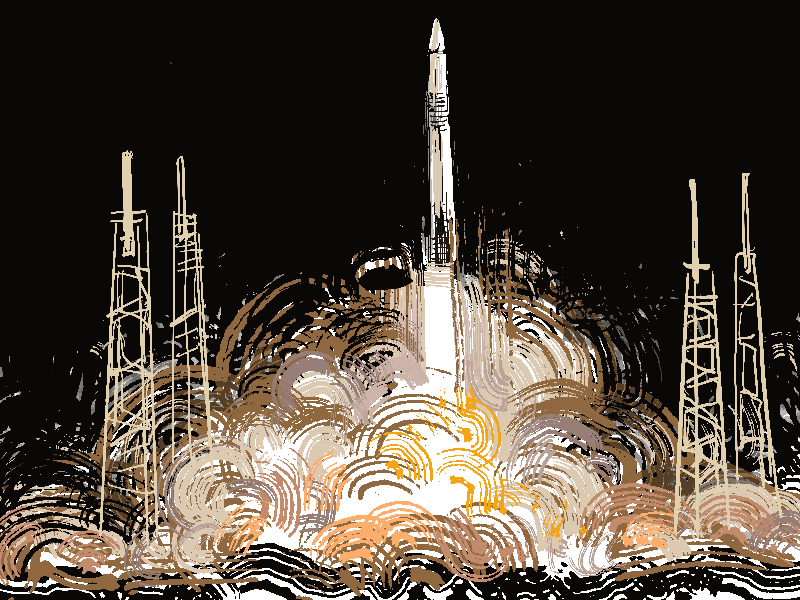SpaceX partners with NASA to send American astronauts to space
An illustration depicting Falcon 9 launching from the Kennedy Space Center in Merritt Island, Florida. The spacecraft was designed and created by SpaceX, a private American aerospace company based in Hawthorne, California.
June 2, 2020
SpaceX, a private American space manufacturing company, sent two NASA astronauts into space on Saturday in a launch from the Kennedy Space Center in Merritt Island, Florida, marking the first time that NASA has sent humans into space from American soil since 2011.
The Falcon 9’s booster successfully landed on the autonomous spaceport drone ship named “Of Course I Still Love You,” with the Crew Dragon capsule continuing to the International Space Station (ISS), a multi-national research laboratory orbiting the Earth.
Astronauts Douglas G. Hurley and Robert L. Behnken, who have both flown on two previous space shuttle missions and have served as military test pilots, were selected to ride on the Falcon 9. Hurley also participated in NASA’s final manned mission in 2011. The astronauts were sent to test the rocket and the Crew Dragon capsule in orbit, the final step before NASA could grant SpaceX permission to fly regularly to the space station.
The Falcon 9 model, designed by SpaceX, is the world’s first reusable rocket, which will lower the cost of space access and exploration, as expensive parts can be used in multiple launches. The Crew Dragon capsule, above the rocket, can hold up to seven people, and it plans to be the first private spacecraft to carry humans to the space station for commercial use. SpaceX was founded in 2002 by Elon Musk with the goal of reducing the cost of space travel.
“Space exploration remains incredibly important to us as a society for a number of reasons,” said Dr. Mark Brada, adviser of the upper school’s Astronomy Club. “For one, I feel like it advances technology. I believe that it gives us a venue to do research under conditions that are not reproducible on earth. But it also gives us something as a society to strive for.”
The two aerospace companies originally planned to launch Demo-2, the final test of SpaceX’s human space program, last Wednesday, May 27, at 1:33 p.m. PDT, but due to unsafe conditions because of poor weather, the event was scrubbed and postponed to Saturday at 12:22 PDT, one of their planned backup dates.
On Wednesday, there was light rain throughout the morning, which cleared up just 15 minutes before the set launch time. However, weather officers decided that the conditions would not be safe until ten minutes after schedule; the later liftoff would prevent the rocket from meeting with the International Space Station, forcing it to be postponed.
“We had, just simply, too much electricity in the atmosphere. There wasn’t really a lightning storm or anything like that, but there was a concern that if we did launch, it could actually trigger lightning,” said Jim Bridenstine, the Administrator of NASA, in a statement following the postponement.
Although American astronauts have been occupying the ISS, this historic event marked the first time in nine years that astronauts were sent to space from within the United States on an American rocket.
“It was definitely something that I would never forget,” Emily Zhou (10), an officer of Astronomy Club, said. “This is the first type of launch I’ve actually seen live before, so when SpaceX launched smoothly and successfully, I wasn’t expecting to hear claps in the background, but when I did, it honestly made me so happy.”
Although NASA shut down its manned missions in 2011, growth in the sector of aerospace research has continued through private companies. These newer companies have the potential to help humans with the development of space exploration.
“I personally feel space exploration will only grow in terms of impact on leading research and society in general,” Anirudh Kotamraju (10), who has been following NASA’s efforts since a young age, said. “With private companies like SpaceX and Blue Origin partnering with government organizations, the idea of commercializing space travel is becoming more and more of a reality. In the short term, it may be restricted to high paying clients, but the ultimate goal would be making space tourism an industry.”


















![“[Building nerf blasters] became this outlet of creativity for me that hasn't been matched by anything else. The process [of] making a build complete to your desire is such a painstakingly difficult process, but I've had to learn from [the skills needed from] soldering to proper painting. There's so many different options for everything, if you think about it, it exists. The best part is [that] if it doesn't exist, you can build it yourself," Ishaan Parate said.](https://harkeraquila.com/wp-content/uploads/2022/08/DSC_8149-900x604.jpg)




![“When I came into high school, I was ready to be a follower. But DECA was a game changer for me. It helped me overcome my fear of public speaking, and it's played such a major role in who I've become today. To be able to successfully lead a chapter of 150 students, an officer team and be one of the upperclassmen I once really admired is something I'm [really] proud of,” Anvitha Tummala ('21) said.](https://harkeraquila.com/wp-content/uploads/2021/07/Screen-Shot-2021-07-25-at-9.50.05-AM-900x594.png)







![“I think getting up in the morning and having a sense of purpose [is exciting]. I think without a certain amount of drive, life is kind of obsolete and mundane, and I think having that every single day is what makes each day unique and kind of makes life exciting,” Neymika Jain (12) said.](https://harkeraquila.com/wp-content/uploads/2017/06/Screen-Shot-2017-06-03-at-4.54.16-PM.png)








![“My slogan is ‘slow feet, don’t eat, and I’m hungry.’ You need to run fast to get where you are–you aren't going to get those championships if you aren't fast,” Angel Cervantes (12) said. “I want to do well in school on my tests and in track and win championships for my team. I live by that, [and] I can do that anywhere: in the classroom or on the field.”](https://harkeraquila.com/wp-content/uploads/2018/06/DSC5146-900x601.jpg)
![“[Volleyball has] taught me how to fall correctly, and another thing it taught is that you don’t have to be the best at something to be good at it. If you just hit the ball in a smart way, then it still scores points and you’re good at it. You could be a background player and still make a much bigger impact on the team than you would think,” Anya Gert (’20) said.](https://harkeraquila.com/wp-content/uploads/2020/06/AnnaGert_JinTuan_HoHPhotoEdited-600x900.jpeg)

![“I'm not nearly there yet, but [my confidence has] definitely been getting better since I was pretty shy and timid coming into Harker my freshman year. I know that there's a lot of people that are really confident in what they do, and I really admire them. Everyone's so driven and that has really pushed me to kind of try to find my own place in high school and be more confident,” Alyssa Huang (’20) said.](https://harkeraquila.com/wp-content/uploads/2020/06/AlyssaHuang_EmilyChen_HoHPhoto-900x749.jpeg)













